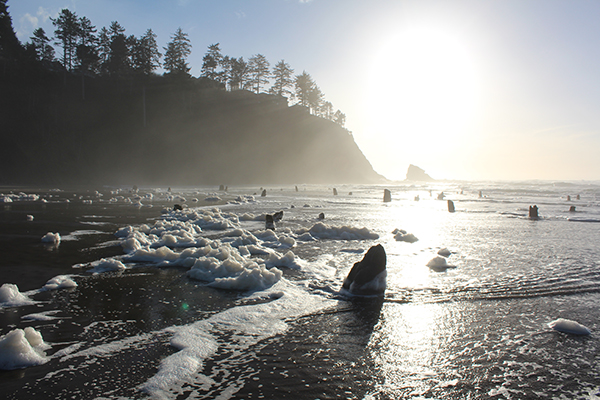The 1700 Cascadia Megathrust Earthquake and the Future of Cascadia Margin
The 1700 tsunami that impacted the Puget sound region was triggered by a megathrust earthquake off the coast of northern California, Oregon, Washington, and British Columbia on the so-called Cascadia margin. The event happened on the evening of January 26th as documented in Japanese historic records. In Japan, the event was called an “orphan” tsunami because the earthquake was so far away it was not felt. The other significant piece of evidence for the tsunami comes from dead trees in so-called “ghost” forests in Oregon and Washington that can be dated using carbon 14 and tree ring studies. These trees in lush coastal forests are thought to have been instantly killed by the saltwater when they were flooded initially by up to 12 m (36 feet) of land subsidence associated with the megathrust earthquake and then by the tsunami. The photo below shows the Neskowin Ghost Forest on the Oregon coast. We see many tree stumps sticking up above the sand at low tide. These trees were killed by a tsunami in 1700 when the elevation of the land fell, and they were completely inundated and then buried by sand. Large storms eroded the sand from the trees and exposed them. They remain as evidence of the huge tsunami more than 300 years ago.

Oral accounts from indigenous Native American and First Nation tribes living on the coast of Vancouver Island in Canada that have been passed down from generation to generation tell of an earthquake and tsunami on a winter’s evening. The accounts describe that all the low-lying settlements were wiped out and the only survivors were those people who lived 75 feet above the waterline. So the tsunami must have been massive!
Subsidence and tsunami records suggest that the earthquake was in the range of a magnitude 8.7-9.2 on the Richter scale. So what is a megathrust earthquake? It’s a very powerful quake usually close to or greater than a magnitude 9. These quakes occur at subduction zones where one plate is thrust under the other. When this happens the overriding plate moves upwards rapidly and this is what typically generates the tsunami. What is incredible about these events is the motion covers such massive areas. In the 2004 Indian Ocean event, an area 180 km wide and 1000 km long moved up by 30 meters! In the 2011 Tohoku event, an area 200 km long by 500 km wide moved up by 20 meters!
Back to Cascadia. The whole margin from Northern California to British Columbia lies about 200 km from the plate boundary where the Juan da Fuca Plate is sliding beneath the North American Plate. Paleoseismology, the exploration of evidence of ancient quakes from rocks, has become a cottage industry here and suggests that a major (i.e. megathrust) quake occurs every 500 years on average. So it’s been 300 years since the 1700 event and thus getting close to the time for another major event. The probability of such a massive quake in the next 50 years is about 12 percent, about 1 in 8, which is not insignificant.

This is the scenario that could play out on the Cascadia margin. A magnitude 9 earthquake rocks the plate boundary leading to a 1000 km long rupture including significant vertical displacement. This generates a tsunami that travels at 800 km/hour. Folks on the coast will feel the earthquake waves first with a magnitude between 7 and 8. This severe shaking will crumble older buildings with poor construction, collapse bridges, and cause landslides and soil liquefaction (when waterlogged soils behave like Jello---see images below from Alaska of the potential damage from liquefaction), stranding communities, and hampering relief. But everyone on the coast will know that the worst is yet to come and that they will need to evacuate as soon as the land stops shaking. The deformation that occurs along the plate boundary could cause land at the coast to sink by up to 6 feet (2m) making the coastal zone much more susceptible to flooding. The first tsunami wave will reach the coast from Victoria Island in Canada to Northern California in 15-20 minutes giving folks very little time to escape to higher ground. The waves could be 30-40 feet (9-12 m) in height when they hit the coast but some models suggest they could reach 100 feet (30 m), and in many parts of the coast they would flood up to 10 miles (16 km) inland. Some parts of the coast are a lot more vulnerable to tsunami inundation than others, and citizens in these locations will have to move to higher ground extremely rapidly once the earthquake waves subside. The waves will keep coming and since they have such long wavelengths it will take hours for the water to subside.
Earthquake Damages
Video: The Next Cascadia Earthquake: Worst-Case Scenario (8:07)
The following video describes the likely impact of a megathrust Cascadia earthquake.
Such a disaster will happen along the Cascadia margin at some time in the future. The damage and impact will depend on the mechanics and location of the quake, the amount of coastal subsidence, the amount of damage by the earthquake, and the height of the tsunami waves. The good news is that public awareness is significant. There has been a lot of media attention and local governments have been investing heavily in public safety projects.
